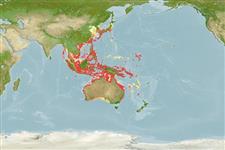Common names from other countries
>
Acanthuriformes (Surgeonfishes) >
Siganidae (Rabbitfishes)
Etymology: Siganus: Latin, siganus = a fish, rabbit fish; by the similarity of the nose (Ref. 45335).
Environment: milieu / climate zone / depth range / distribution range
Sinh thái học
Biển; Thuộc về nước lợ Cùng sống ở rạn san hô; Ở đại duơng, biển (Ref. 51243); Mức độ sâu 1 - 50 m (Ref. 9813). Tropical; 42°N - 37°S, 90°E - 171°E
Western Pacific: southern Korea, southern Japan, Ogasawara Islands, Taiwan, southern China, Malaysia, Singapore, Thailand, Andaman Islands, Indonesia, Philippines, Yap, Palau, Pohnpei (Caroline Islands), Solomon Islands, Papua New Guinea, Vanuatu, New Caledonia, and Australia. Often misidentified as Siganus canaliculatus (Ref. 2334).
Length at first maturity / Bộ gần gũi / Khối lượng (Trọng lượng) / Age
Maturity: Lm 5.6 range ? - ? cm
Max length : 40.0 cm TL con đực/không giới tính; (Ref. 9813); common length : 25.0 cm TL con đực/không giới tính; (Ref. 9813)
Các tia vây lưng cứng (tổng cộng) : 13; Các vây lưng mềm (tổng cộng) : 10; Tia cứng vây hậu môn: 7; Tia mềm vây hậu môn: 9; Động vật có xương sống: 13. Body olive green or brown above, silvery below; fish frequently with a dark patch below origin of lateral line. Adults become mottled when frightened. Slender, pungent, venomous spines. Preopercular angle 89°-95°. Lower half to 2/3 of cheeks commonly covered with weak, scattered scales. Midline of thorax between pelvic ridges. Differs from S. argenteus in details of coloration and less deeply forked tail (Ref. 37816).
Inhabits algal and seagrass flats and shallow lagoon and coastal reefs (Ref. 9710, 11230). Forms schools. Mainly diurnal. Juveniles feed on filamentous algae, adults feed on leafy algae and seagrasses (Ref. 9710). Commercially cultured in Japan. Commonly found in large estuaries (Ref. 9002). Anterolateral glandular groove with venom gland (Ref. 57406).
In Belau, ripe individuals form prespawning congregations of 30-60 individuals in shoal areas of inner reef flats; spawning occurs on the 4th or 5th day of the new moon; spawning sites are near reef edge. About 300,000 eggs/female at a single spawning. Individuals that spawn in consecutive yrs. & that 2+ yr. class fish could spawn more than once in a single season. Aug (Ref 1754) in Belau.
Woodland, D.J., 1990. Revision of the fish family Siganidae with descriptions of two new species and comments on distribution and biology. Indo-Pac. Fish. (19):136 p. (Ref. 1419)
IUCN Red List Status (Ref. 130435)
CITES (Ref. 128078)
Not Evaluated
Human uses
Các nghề cá: Tính thương mại; Nuôi trồng thủy sản: Tính thương mại
Các công cụ
Special reports
Download XML
Các nguồn internet
Estimates based on models
Preferred temperature (Ref.
115969): 22.6 - 29, mean 27.9 (based on 760 cells).
Phylogenetic diversity index (Ref.
82804): PD
50 = 0.5000 [Uniqueness, from 0.5 = low to 2.0 = high].
Bayesian length-weight: a=0.01288 (0.00826 - 0.02009), b=2.99 (2.86 - 3.12), in cm Total Length, based on LWR estimates for this species & Genus-body shape (Ref.
93245).
Mức dinh dưỡng (Ref.
69278): 2.0 ±0.1 se; based on diet studies.
Thích nghi nhanh (Ref.
120179): Chiêù cao, thời gian nhân đôi của chủng quần tối thiểu là dưới 15 tháng (Preliminary K or Fecundity.).
Fishing Vulnerability (Ref.
59153): Low vulnerability (21 of 100).
